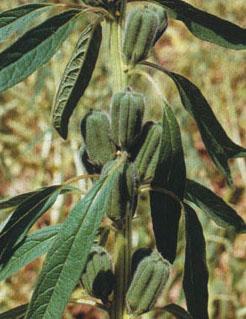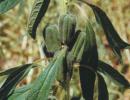
|
Sesame
Scientific name:
Sesamum indicum
Order/Family:
Scrophulariales: Pedaliaceae
Local names:
Ufuta (Swahili), selit (Amharic)
Pests and Diseases:
Aphids
Bacterial blight
Bacterial leaf spot
Cutworms
Fusarium wilt
Leaf spot
Powdery mildew
Simsim gall midge
Spider mites
Stem rot or charcoal rot of bean
Whiteflies
Simsim webworm, Sesame seed bug, Stink bug or Cluster bug
|
Aphids (Aphis spp.)
Aphids are a major pest, causing leaves to curl and attacked capsules become unattractive to customers.
Aphids feed by sucking plant sap. Small aphid populations may be relatively harmless, but heavily infested plants usually have wrinkled leaves, stunted growth and deformed capsules. Plants, in particular young plants, may dry out and die under heavy aphid attack. Heavy attack on older plants may cause crop loss by decreasing flower and seed production. Damage may also reduce seed viability.
- Monitor regularly the crop.
- Whenever necessary spray only affected plants (spot spraying).
- Use biopesticides that are not harmful to natural enemies (for instance neem, ashes, soapy water). In Kenya, foliar sprays with neem products such as Neemroc® (1-3%) and Neemros® water extract (50g/l) controlled the black bean aphid on vegetables (Maundu, 1997). For more information on biopesticides click here
- Conserve natural enemies. They are important in natural control of aphids. For more information on natural enemies click here
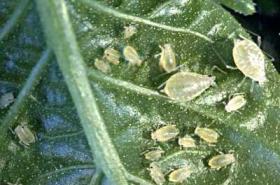
© Magnus Gammelgaard
Bacterial blight (Xanthomonas campestris pv. sesami)
Water soaked, small and irregular spots are formed on the leaves which later increase in number and turn brown. Severely infected leaves defoliate. Later, the spots are formed on the twigs which bear poor capsules. Spots appear from 4 to 6 leaf stage of the crop and continue till maturity. Seed treatment with hot water at 52°C for 10 minutes is recommended.
- Treat seeds in hot water: 10 min. at 52°C. For more information on hot-water treatment of seeds click here.
- Cultivate at low humidity and temperature (change sowing date).
- Destroy crop residues.
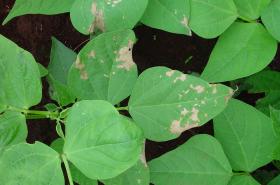
© A.M. Varela, icipe

Bacterial …

Bacterial …
Bacterial leaf spot (Pseudomonas syringae pv. sesami)
Light brown angular spots with dark purple margin appear in the leaf veins.
Defoliation and death of plant may occur in severe leave and stem infection. Sunken and shiny spots appear on the capsules. Early capsule infection renders them black and seedless. The pathogen is seed borne. High temperature, rainfall and persistent humidity favour the disease.
- Hot water treat seeds: 10 min. at 52°C. For further information on hot-water treatment of seeds click here.
- Use white seeded varieties. They are reported to be more resistant than coloured varieties.
- Destroy crop residues.
- Use resistant varieties, if available.
- Cultivate at low humidity and temperature (change sowing date).
Cutworms (Agrotis spp.)
Cutworms are caterpillars of Agrotis moth. The adult moth is grey to brown with a wingspan of about 4 cm and have lighter coloured hind wings. Whitish yellow eggs are laid at night on leaves. The eggs turn darker as hatching approaches. Young larvae may feed on leaves and cause tiny holes but they drop to the ground after a few days.
Mature larvae are about 4 cm long. They are easy to recognise by their smooth skin, greasy grey / orblack colour and C-shaped posture when disturbed. Cutworms emerge at night causing serious damage by cutting young plants at the base of the stem. Cutworm infestation is often associated with fields that are weedy, have high amounts of organic residue or are very wet due to poor drainage or heavily irrigated.
- Till weeds early, before harvest.
- Use light traps against moths, where feasible.
- Ploughing can help by exposing larvae to predators and can also bury others so that they cannot reach soil surface.
- Flooding of the fields a few days before planting can kill larvae in the soil.
- Use preparations made of neem or pyrethrum.
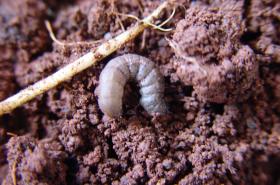
© A.M. Varela, icipe
Fusarium wilt (Fusarium oxysporum f. sp. sesam)
It is a fungal disease. Symptoms include partial or total wilting of plants at flowering and podding, a purple band of stems extending from the base upwards, browning of the stem tissue in the purple band area, and browning or blackening of internal tissue when the main stem or primary branches are split. Infected young plants may not show the purple band symptom but have conspicuous internal browning and blackening. Affected fields show patches of dead plants. The fungus survives on infected crop debris in the soil for about three years. Infection occurs from seeds or soil. Non-opening varieties are not as susceptible.
- If the soil is strongly infested, do not grow sesame for at least 5 years.
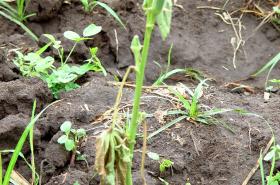
© A.M. Varela & A.A.Seif, icipe

Fusarium w…

Fusarium w…
Leaf spot (Alternaria spp.)
The pathogen attacks all parts of the plant at all stages. Small, dark brown water soaked, round to irregular lesions, with concentric rings, 1-8 mm in diameter appear on the leaves and under excessive atmospheric and soil humidity the spot increases in size and number. The lesions may also appear on the midrib and veins of the leaves. Milder attacks cause only defoliation, in severe cases the plant may die. The pathogen is seed-borne. Temperature of 20-30o C and humid conditions favour the disease.
- Use certified disease-free seeds.
- Use resistant varieties where available. Varieties totally covered with hair seem to be resistant.
- Destruction of crop residues and weeds.
- Early planting i.e. immediately after onset of rains.
- Follow intercropping system of sesamum + sunflower.
- Copper based fungicides could be used as a preventive measure when conditions are conducive to disease development.
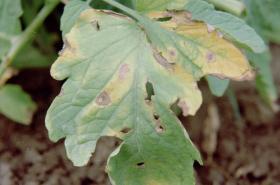
© Courtesy EcoPort (http://www.ecoport.org): Clemson University
Powdery mildew (Sphaerotheca fuliginea, Leveillula taurica, Erysiphe cichoracearum)
The disease can infect all aerial parts: leaves, flowers and pods. Characteristic of the disease is white greyish powdery fungal growth on affected plant parts. Small pale yellow chlorotic spots develop on the upper surface of leaves and the corresponding lower surface develops white greyish powdery fungal growth. With time the powdery growth covers the entire upper and lower leaf area. Severe infection causes heavy leaf drop. The fungus develops at temperatures ranging from 20 to 35º C, but 25º C is the optimum. The fungus survives on perennial pigeon peas and volunteer plants, and on the ratoon growth of the harvested plants.
- Use resistant varieties, if available. Late ripening varieties are less susceptible.
- Use sulphur dust 20 kg/ha on the 45th and 65th day after sowing.
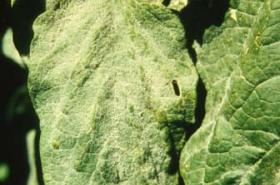
© Courtesy EcoPort (http://www.ecoport.org): Jürgen Kranz
Simsim gall midge or gall fly (Asphondylia sesami)
The adult is a 5 mm long red-bodied midge (mosquito-like fly). Female midges lay eggs along the veins of terminal leaves. The larvae are typical maggots; they are whitish to orange in colour, legless and with body tapering exteriorly and grow up to 3 to 4 mm in length. Maggots feed inside the floral buds and young capsules leading to formation of galls of up to 6 mm in diameter. They pupate inside the galls. Attacked flower buds wither and drop, or become twisted and stunted and do not develop in to flower/capsules. The simsim gall midge is usually a minor pest, but occasionally high infestations occur resulting in considerable crop losses. Generally plants with green capsules appear to be more susceptible to attack than plants with black capsules.
- Monitor plants at the time of bud initiation.
- Use resistant or tolerant varieties where available (The following varieties are recommended in India: "RT-46", "Swetha Til", "RT-103", "RT-108", "RT-125" and "RT-127")
- Intercrop with mungbean, pearl millet or groundnut.
- Clip the galls, pick and burn the shed buds.
- Conserve natural enemies. Parasitic wasps, like species of Eurytoma, parasitise maggots of the gall fly.
- Use neem products when necessary. They help reducing capsule damage by gall flies, and providing higher seed yield. In trials in India the commercial products "Neemgold" and "Neembicidine" were found more effective than neem leaf extract, neem seed kernel extract, neem oil, "NNG-4", "Neemark" and "Neemax" (AHUJA and KALYAN, 2001).
Spider mites (Tetranychus spp.)
Eggs of red spider mites are round, white or pink and of size about 0.1 mm. Eggs are usually laid on the under-surface of leaves. They hatch into six-legged larvae, light green in colour, which become reddish coloured adults. The adults are about 0.25 -0.6 mm long. They have eight legs, and produce a fine silk webbing that protects them predators and pesticide sprays. Infested leaves are spotted, yellowish or silvery as a result of feeding by red spider mites. Infested capsules exhibit white speckling. The red spider mites are dispersed by wind and human activity on clothes while working in infested fields. Their development is favoured by warm weather and insufficient rains.
- Field hygiene is important as an old crop or weeds infested with mites can cause infestation of any new crop grown nearby, particularly, if it is downwind of the old crop.
- Interplanting with garlic, basil or onion is said to give some protection due to their strong smell.
- Encourage natural enemies. This can be achieved by planting flowering plants around the field
- Spray preparations made of garlic (click here), neem (click here) or soap (click here)
- Use a preparation of flour: 2 cups of fine, white flour, add 5-10 l water, mix well, spray infected plants early in the morning. The pests will drop off with the crust during the day. For more information on flour spray click here. For more information on natural enemies click here
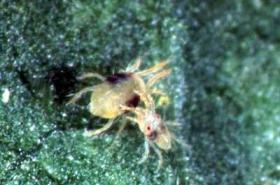
© Warwick HRI, University of Warwick.
Stem rot (charcoal rot of bean) (Macrophomina phaseolina)
Initial symptom on stems and branches are spindle-shaped spots with light grey centres surrounded by brown margins. The centres of the spots have scattered dots (pycnidial bodies - fungal spores). The spots may join up and cause the branches or whole plants to dry up and die. Diseased plants suddenly wilt. When diseased plants are uprooted their roots are rotten and shredded. The fungus mainly attacks secondary finer roots. These roots have dark, blackened streaks underneath their barks with dots (pycnidial bodies - fungal spores). Disease development is favoured by hot dry weather (30º C). Crops are more susceptible to the disease in the reproductive than in the vegetative stage.
- Use green manure.
- Use resistant or less susceptible varieties (e.g. red shelled varieties).
Whiteflies (Bemisia tabaci)
Whiteflies are extremely polyphagous. They are a vector of many virus diseases. Whitefly feeding produces a honeydew, which is conducive to the development of sooty mould and also attracts ants. Whitefly incidence is favoured by dry conditions .
- Parasitoids can play an important role in reducing whitefly numbers. Flowering plants should be grown around the field to provide food source to the parasitoids and pesticide spraying should be discouraged.
- Neem seed extracts controls young nymphs, inhibits growth and development of older nymphs, and reduces egg laying capacity by adults. For further information on neem click here.
- Spraying with soapy water solutions can be effective in whitefly management
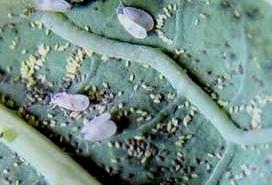
© A. M. Varela, icipe
| General Information and Agronomic Aspects | Information on Pests | |||
| Information on Diseases | Information Source Links |
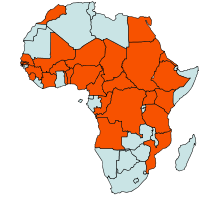 |
| Geographical Distribution of Sesame in Africa |
Sesame originates in East Africa and is the oldest of the commercial oil seeds. The oil is a clear edible oil with a pleasant taste and a very good long shelf life if properly refined. Sesame has an oil content of 48-55% which is the highest of any oil crop while the protein content ranges from 44 to 48%.
Sesame seeds are either consumed directly as a highly nutritious foodstuff or processed by the confectionery and bakery industries. The seed hulls, which are bitter due to their oxalic content, can be removed with the use of steam. Ragouts and soups are often prepared with crushed sesame seeds. Sesame hay, if carefully dried, can be used as fodder. A large proportion of the world's sesame production goes towards producing edible oil.
Purely white sesame seeds are in demand on conventional and on ecological markets, because of their higher oil content than pigmented varieties.
By-products of oil extraction are an excellent protein component to mix into animal feed.
Nutritive Value per 100 g of edible Portion
| Raw or Cooked Sesame | Food Energy (Calories / %Daily Value*) |
Carbohydrates (g / %DV) |
Fat (g / %DV) |
Protein (g / %DV) |
Calcium (g / %DV) |
Phosphorus (mg / %DV) |
Iron (mg / %DV) |
Potassium (mg / %DV) |
Vitamin A (I.U) |
Vitamin C (I.U) |
Vitamin B 6 (I.U) |
Vitamin B 12 (I.U) |
Thiamine (mg / %DV) |
Riboflavin (mg / %DV) |
Ash (g / %DV) |
| Sesame Oil | 884.0 / 44% | 0.0 / 0% | 100.0 / 154% | 0.0 / 0% | 0.0 / 0% | 0.0 / 0% | 0.0 / 0% | 0.0 / 0% | 0.0 IU/ 0% / | 0.0 / 0% | 0.0 / 0% | 0.0 / 0% | 0.0 / 0% | 0.0 / 0% | 0.0 |
| Sesame seeds, whole, dried | 573.0 / 29% | 23.4 / 8% | 49.7 / 76% | 17.7 / 35% | 975.0 / 98% | 629.0 / 63% | 14.5 / 81% | 468.0 / 13% | 9.0 IU / 0.0 | 0.0 / 0% | 0.8 / 40% | 0.0 / 0% | 0.8 / 53% | 0.2 / 15% | 4.5 |
Sesame only grows well in a warm climate and in East Africa it is only grown from sea level up to 1500 m. Most varieties of sesame are photoperiod sensitive .
In Kenya sesame is grown in the following areas:
- Coast Province - Kwale, Kilifi and Lamu districts
- Western Province - Busia, Bungoma and Kakamega
- North Eastern Province - Mandera
- Eastern Province - Meru
Good harvests can be expected when rainfall of 300-600 mm is equally distributed throughout the vegetation period. Optimum rainfall times: 35% before the first cusps are formed, 45% during the main blossoming period, 20% during the ripening period. Drought during harvesting is preferred. During each of its development stages, the plant is highly susceptible to water-logging, and can therefore only thrive during moderate rainfall, or when irrigation is carefully controlled in drier regions. Due to its tap roots, the plant is highly resistant to drought and can provide good harvests, when soil moisture is adequate.
A wide range of soils are suitable for sesame cultivation. Optimal are well-drained, loose, fertile and sandy alluvial soils that have a pH value between 5.4 and 6.75. When irrigated, or during summer rain spells, sesame grows better in sandy than in heavy soils because it is very sensitive to high soil moisture content. It is not recommended to plant sesame on sloping ground, because its need of weed-free seed beds and its slow rate of early development can lead to erosion.
Sesame tolerates temperatures of 24-33°C and the crop matures in 120-140 days.
Varieties
There are local varieties of sesame with black, white and brown seed colours. The black varieties are grown in the coastal region and the white in the western region of Kenya.
Imported varieties have lower performance than local varieties. The best of the imported varieties is "Morada", identified by its purple stems and leaves. It originated in Congo and further selected in Venezuela. It is higher yielding and more resistant to aphid attack. The local sesame varieties are branched and drought resistant but have a low yielding capacity and are susceptible to most diseases.
There are several cultivation methods:
- Direct sowing in holes, with stick for support.
- Sowing after narrow strips have been prepared.
- Drilling in rows about 45 cm apart and later thinned (at a height of about 5-10 cm) to a distance of 15-20 cm within the row.
Intercropping. Sesame is often sown with other crops such as pigeon peas, maize or sorghum. It grows to a height of 1-2 m.
Additional measures in weed control include:
- Early working in of the weeds and harvest residues from the previous crop.
- The planting of rapidly-growing varieties.
- Include plants in the crop rotation that cast strong shadows, or are good ground coverers (e.g. green manure plants).
- Bottom crops: Ground-covering legumes can be sown between the rows to suppress weed growth (e.g. groundnuts).
The plants are cut to a height of 10-15 cm, or uprooted before the capsules are fully ripened. The optimum time for harvesting is when:
- The first, lowest capsules turn brown and begin to pop open.
- The stem turns yellow.
- The leaves begin to fall off.
- Blossoming has finished.
- The leaves have turned yellow.
Sesame is generally harvested by hand, and then left to dry for the first 2-3 days after cutting in a windrow. The leaves dry out quickly there, making it easier to bundle them into sheaves. The sheaves should be positioned so that the sun can shine down directly onto the capsules. The sheaves should be small (diameter of 15 cm, bottom: 45-80 cm). During harvesting, the planting seeds should not be allowed to come into contact with the ground to avoid an infestation of soil borne diseases. The seed shells must remain intact to protect the seeds from infection, and to maintain their ability to germinate.
When the sheaves have dried out fully, they are tipped out onto sturdy cloths or canvases and threshed with sticks. To achieve maximum quality (and market price) the threshing cloths/canvases should be at least 2mx3m to avoid contamination with soil particles. Directly following the threshing, the sesame seeds are sieved of leaves, stems and capsule residues, and then dried out to a moisture content of 6% as rapidly as possible. This can be done on a clean, sun-drenched concrete base preferably covered by a clean plastic sheet to avoid contamination.
Yields. With good management, yield should be between 450-550 kg/ha. "Morada" variety can yield twice.
(Naturland e.V. 2002)
|
Bacterial leaf spot (Pseudomonas syringae pv. sesami) Light brown angular spots with dark purple margin appear in the leaf veins.
Defoliation and death of plant may occur in severe leave and stem infection. Sunken and shiny spots appear on the capsules. Early capsule infection renders them black and seedless. The pathogen is seed borne. High temperature, rainfall and persistent humidity favour the disease. |
|
|
What to do:
|
|
Bacterial blight (Xanthomonas campestris pv. sesami) Water soaked, small and irregular spots are formed on the leaves which later increase in number and turn brown. Severely infected leaves defoliate. Later, the spots are formed on the twigs which bear poor capsules. Spots appear from 4 to 6 leaf stage of the crop and continue till maturity. Seed treatment with hot water at 52°C for 10 minutes is recommended. | 
Bacterial blight
Bacterial blight on beans © A.M. Varela, icipe |
|
What to do:
|
|
Aphids (Aphis spp.) Aphids are a major pest, causing leaves to curl and attacked capsules become unattractive to customers. | 
Aphids
Aphids (Myzus persicae). Adult wingless females are oval-bodied, 1.2-2.1 mm in body length, of very variable colour. © Magnus Gammelgaard |
|
What to do:
|
|
Whiteflies (Bemisia tabaci) Whiteflies are extremely polyphagous. They are a vector of many virus diseases. Whitefly feeding produces a honeydew, which is conducive to the development of sooty mould and also attracts ants. Whitefly incidence is favoured by dry conditions . | 
Cabbage whitefly
Adults and eggs of the cabbage whitefly (Aleyrodes proletella). © A. M. Varela, icipe |
|
What to do:
|
|
Spider mites (Tetranychus spp.) Eggs of red spider mites are round, white or pink and of size about 0.1 mm. Eggs are usually laid on the under-surface of leaves. They hatch into six-legged larvae, light green in colour, which become reddish coloured adults. The adults are about 0.25 -0.6 mm long. They have eight legs, and produce a fine silk webbing that protects them predators and pesticide sprays. Infested leaves are spotted, yellowish or silvery as a result of feeding by red spider mites. Infested capsules exhibit white speckling. The red spider mites are dispersed by wind and human activity on clothes while working in infested fields. Their development is favoured by warm weather and insufficient rains. | 
Spider mites
Two-spotted spider mite (Tetranychus urticae). The adult female is 0.6 mm long. The male is smaller. © Warwick HRI, University of Warwick. |
|
What to do:
|
- Acland, J. D. (1980). East African Crops. An introduction to the production of field and plantation crops in Kenya, Tanzania and Uganda. FAO / Longman Group Ltd, London. ISBN: 0 582 60301 3
- Ahuja D. B., Kalian R. K. (2001). Seasonal incidence of gall fly, Asphondylia sesami and efficacy of various neem based formulations, against it on sesame, Sesamum indicum. Indian journal of entomology. Vol. 63, no4, pp. 409-412. ISSN 0367-8288.
- Hill, D. S. (1975). Agricultural Insect pests of the tropics and their control. ISBN: 0-521-20261-2.
- Insect Pest Management in Sesamum. In With Support of TIFP, Ministry of Science & Technology, Dpt. of Scientific & Industrial Research, GoI. Designed And Developed at Directorate of Instrumentation, JNKVV, Jabalpur, MP. www.jnkvv.nic.in
- Naturland e.V. (2002). Organic Farming in the Tropics and Subtropics, Exemplary Description of 20 Crops. Sesame.
- Nutrition Data www.nutritiondata.com.
- Organisation for Non-Chemical Pest Management in the Tropics (OISAT). www.oisat.org

 Back
Back
